
Trellick Tower is a Grade II* listed tower block on the Cheltenham Estate in Kensal Town, London. Opened in 1972, it was commissioned by the Greater London Council and designed in the Brutalist style by architect Ernő Goldfinger. The tower was planned to replace outdated social accommodation, and designed as an improvement on Goldfinger's earlier Balfron Tower in Poplar, East London. It was the last major project he worked on, and featured various space-saving designs, along with a separate access tower containing a plant room.
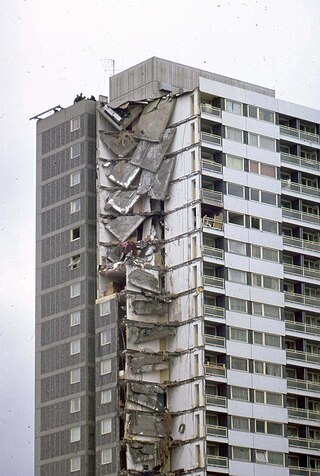
Ronan Point was a 22-storey tower block in Canning Town in Newham, East London, that partially collapsed on 16 May 1968, only two months after it opened. A gas explosion blew out some load-bearing walls, causing the collapse of one entire corner of the building; four people died and 17 were injured. The nature of the failure led to a loss of public confidence in high-rise residential buildings, and major changes in British building regulations resulted.
The Lakanal House fire occurred in a tower block on 3 July 2009 in Camberwell, London. Six people were killed, and at least 20 injured, when a high-rise fire, caused by a faulty television set, developed and spread through a number of flats in the twelve-storey building.
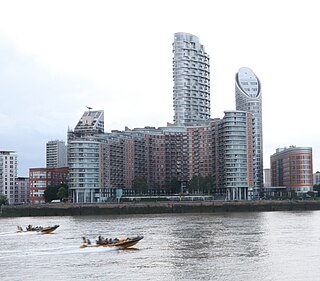
The New Providence Wharf is a residential development in the Blackwall district of the London Borough of Tower Hamlets, at the north end of the Blackwall Tunnel. It was designed by Skidmore, Owings and Merrill and is managed by Ballymore, a property development company.

The First Interstate Tower fire was a high-rise fire that occurred on May 4, 1988, at the First Interstate Tower in Los Angeles, California, a 62-story, 860 foot skyscraper, then the tallest building in the city. The fire destroyed five floors of the building, injured 40 people, and caused the death of a maintenance worker, when the elevator he was riding opened onto the burning 12th floor.
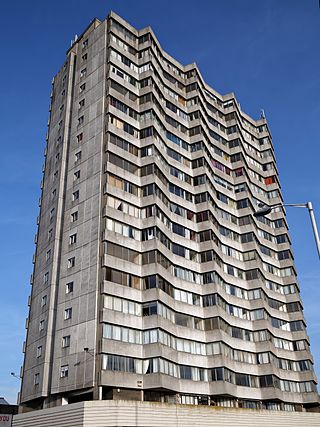
Arlington House is an 18-storey residential apartment and commercial block in the Brutalist style on the seafront of Margate, Kent, England, next to Margate railway station and Dreamland Margate. It was developed by Bernard Sunley and designed by Russel Diplock, and is known for every apartment having a sea view.

On 14 June 2017, a high-rise fire broke out in the 24-storey Grenfell Tower block of flats in North Kensington, West London, England, at 00:54 BST and burned for 60 hours. Seventy people died at the scene and two people died later in hospital, with more than 70 injured and 223 escaping. It was the deadliest structural fire in the United Kingdom since the 1988 Piper Alpha oil-platform disaster and the worst UK residential fire since the Blitz of World War II.
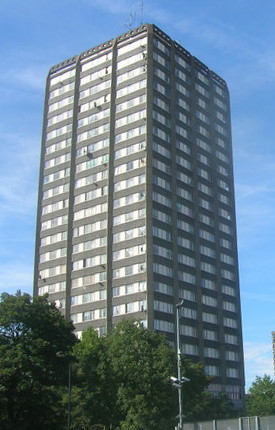
Grenfell Tower is a derelict 24-storey residential tower block in North Kensington in London, England. The tower was completed in 1974 as part of the first phase of the Lancaster West Estate. Most of the tower was destroyed in a severe fire on 14 June 2017.

Tower blocks are high-rise buildings for residential use. These blocks began to be built in Great Britain after the Second World War. The first residential tower block, "The Lawn", was constructed in Harlow, Essex, in 1951; it is now a Grade II listed building. In many cases, tower blocks were seen as a "quick-fix" to cure problems caused by the existence of crumbling and unsanitary 19th-century dwellings or to replace buildings destroyed by German aerial bombing. It was argued that towers surrounded by public open space could provide for the same population density as the terraced housing and small private gardens they replaced, offering larger rooms and improved views, whilst being cheaper to build.
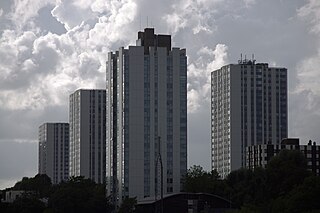
Chalcots Estate is a council housing estate on Adelaide Road and Fellows Road in Swiss Cottage in the London Borough of Camden. It was designed by Dennis Lennon and Partners. The Chalcots Estate was built on land owned by Eton College, which is reflected in the names of the individual buildings.
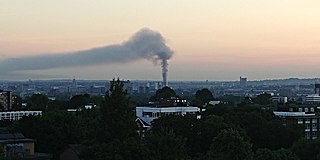
The Grenfell Tower Inquiry is a British public inquiry into the Grenfell Tower fire, which killed 72 people and destroyed Grenfell Tower on 14 June 2017. It was ordered by Prime Minister Theresa May on the day following the fire.

The Knowsley Heights fire occurred on 5 April 1991 at the 11-story Knowsley Heights tower block in Huyton, Merseyside. No-one was injured in the fire.
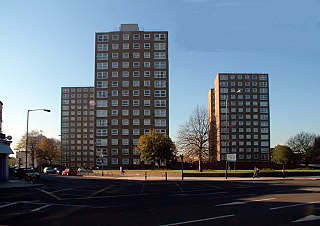
The Ledbury Estate is a large estate of social housing, in Peckham in the London Borough of Southwark. The estate is just south of the Old Kent Road, part of the A2 4 kilometres (2.5 mi) from both Tower Bridge and the Elephant & Castle it is adjacent to land used by George Livesey for the South London Gasworks.
The Shirley Towers Fire occurred in a tower block on 6 April 2010 in Southampton, Hampshire, England. Two firefighters were killed when a fire developed and spread from the ninth floor. The investigations and inquiries following the fire led to changes in fire safety rules nationally, particularly the regulations around electrical wiring.
The Barking fire was a structure fire that occurred on 9 June 2019 at a newly built six storey block of flats named Samuel Garside House, located in De Pass Gardens, Barking, London, the United Kingdom.
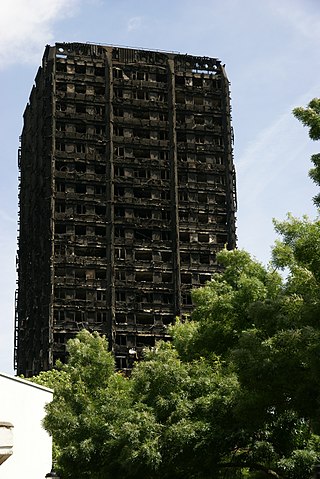
On 14 June 2017, the Grenfell Tower fire broke out in the 24-storey Grenfell Tower block of flats in North Kensington, West London, at 00:54 BST; it caused 72 deaths, including those of two victims who later died in hospital. More than 70 others were injured and 223 people escaped. It was the deadliest structural fire in the United Kingdom since the 1988 Piper Alpha disaster and the worst UK residential fire since the Second World War.
The Grenfell Tower Inquiry is a British public inquiry into the Grenfell Tower fire, which killed 72 people and destroyed Grenfell Tower, a residential building in the Royal Borough of Kensington and Chelsea, London, on 14 June 2017. It was ordered by Prime Minister Theresa May on the day following the fire.

Criticism of the response to the Grenfell Tower fire primarily consisted of condemnation of issues with the emergency response and fire safety regulation practices in the UK at the time. Broader political criticism was also directed at British society, including condemnation of the response by governmental bodies and UK politicians, social divisions, deregulation issues, and poor transparency overall.
The Freshwater Road fire was a fire that broke out in the Spectrum Building, a block of flats on Freshwater Road, Dagenham on 26 August 2024. Four people were injured and treated at the scene with a further two being taken to hospital. Comparisons were immediately drawn to the 2017 Grenfell Tower fire by several news outlets.














